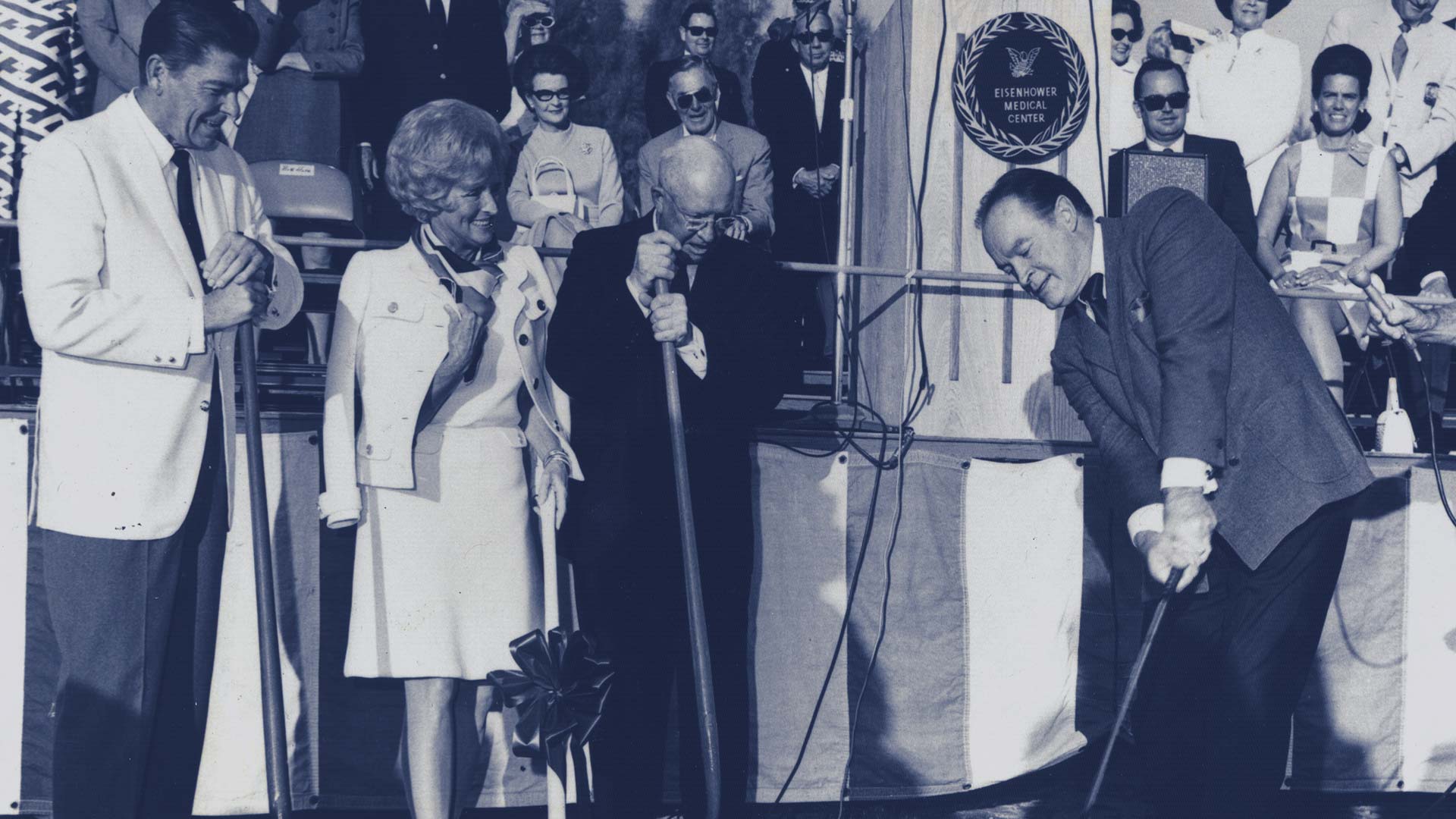Click here to see our full infographic
With the death of Barbara Sinatra at age 90 on July 25, we at Eisenhower Medical Center have reflected on the passing of a generation of patrons whose philanthropy laid the foundation for our world-class reputation.
Sinatra, wife of Old Blue Eyes Frank and high-powered celebrity in her own right, was a driving force behind the Barbara Sinatra Childrens Center, a state-of-the-art nonprofit facility located on our main Rancho Mirage campus. Created in 1986, the Center provides individual, group, and family therapy services for children who suffer, or who are at risk of suffering, child abuse and neglect. More than 20,000 children have been treated at the Center since its inception; its clinicians conduct 7,800 therapy sessions each year.
Along with her husband, Sinatra’s commitment to the Center was legendary throughout the Coachella Valley. She was perhaps the last in a line of luminaries who lent not just their names, but their dollars, time, and effort, to the growth of Eisenhower Medical Center.
We remember and honor both Sinatras and our storied history, not only to reflect on how far we’ve come, but also to reinforce the strongly held values — of compassionate service and clinical excellence — with which it all began.
The Beginning
Much of our storied past began with a hope — Dolores Hope, actually. The wife of legendary comedian Bob Hope, Dolores responded to a friend’s call to help raise funds to establish a much-needed community hospital in the central Coachella Valley. The friend, Florence Swanson, wife of W. Clarke Swanson (of Swanson Foods’ TV dinner fame), had lost her husband to a brain aneurysm he suffered while on the links at Rancho Mirage’s Thunderbird Country Club. Clarke was just yards from his home at the time, but miles from the nearest hospital.
Dolores joined Florence and a small group of similarly minded friends in the belief that a single hospital, then located in Palm Springs, was insufficient to serve the growing health care needs of the valley. An idea hatched by influential residents of Rancho Mirage and Palm Desert bolstered the group’s initial fundraising efforts: Dedicate a portion of the proceeds of a celebrity magnet, the famous Palm Springs Desert Golf Classic (the Bob Hope Desert Classic since 1965), to the new hospital project.
As the Desert Sun reported, the fledgling project, incorporated as the Palm Desert Community Hospital in the early 1960s, drew the attention of the glitterati who, residing in the Palm Springs and Rancho Mirage areas at the time, characterized the area as a celebrity hub. Expressing great honor, new Rancho Mirage residents, former President Dwight D. Eisenhower (who had been golfing with Clarke Swanson at the time of his death) and his wife Mamie agreed to lend their name to the hospital project.
The Dedication and Hard Work
But it was the Hopes, both Dolores and Bob, whose commitment, energy, and resources laid much of the foundation for the medical center. In 1966 the couple donated 80 acres of land for the site of the hospital and went on to serve as its chief champions. Dolores was named president of the hospital’s board of trustees in 1968; a year later Bob emceed the medical center’s groundbreaking ceremony, and Dolores led the creation of the Eisenhower Medical Center Auxiliary.
The Hopes’ superstar chops drew a host of big-name contributors — in talent and resources — to the hospital project. A star-studded line of Hollywood celebrities, from the Sinatras to Bing Crosby, George Burns, Gene Autry, Lucille Ball, and Sammy Davis, Jr., participated in fundraising events (frequently swanky black tie affairs that recruited other celebrities to the cause and raised millions of dollars). An equally impressive band of the politically elite — the Eisenhowers, of course, but also Presidents Richard Nixon, Gerald Ford, George H.W. Bush; Vice President Spiro Agnew; and then-Governor Ronald Reagan — threw their considerable weight behind the project by participating in dedications and other ceremonial activities.
Regrettably President Eisenhower died just months before the medical center’s groundbreaking ceremony, but the Hopes remained earnestly committed to the fruition of the project. Bob hosted the dedication of the then-called Eisenhower Memorial Hospital in November 1971; and he continued over the ensuing years to preside over or attend dedications, such as the hospital’s Mamie Eisenhower wing; the Annenberg Center for Health Sciences (named for publisher, diplomat, and renowned philanthropist Ambassador Walter Annenberg); the Betty Ford Center; the Dolores Hope Outpatient Care Center; and, of course, the Barbara Sinatra Childrens Center.
Bob passed away at age 100 in July 2003. While in many ways he represented the face of the organization, Dolores’s contributions remained hands-on. She served on the medical center’s board of directors and as chairman emeritus of its board of trustees until her death in September 2011.
The Results
Despite our prestigious beginnings, Eisenhower Medical Center wasn’t built on fame alone. Beneath the glitz and glamour associated with our founders lay a deep-rooted desire to serve the community — not just with health care services, but with top-notch, best-of-the-best health care services.
Eisenhower Medical Center rose to that challenge. As our facilities and staff grew, so, too, did our reputation as a premier health care provider. Our embrace of innovation links back to the pioneering spirit of the men and women who laid our foundation, and we’ve honored that heritage with numerous clinical firsts in the Coachella Valley and beyond. Among them:
- First installation of a Magnetic Resonance Imaging system in the Coachella Valley (1986)
- First in the valley to perform cardiac resynchronization therapy for heart failure and to use a dedicated electrophysiology OR to diagnose and treat heart abnormalities (2001)
- First Coachella Valley medical center to install a computer-aided detection system for breast cancer screenings (2002)
- First hospital in California to use barcode technology to prevent medication and transfusion errors at the bedside (2002)
- First hospital in the valley to perform a cochlear implant (2004)
- First hospital in the world to combine use of external beam radiation therapy with Cesium-131 in the treatment of prostate cancer (2005)
- First Coachella Valley medical center to perform cervical artificial disc surgery (2006)
- First hospital in Southern California to use Breast-Specific Gamma Imaging to accurately identify breast cancer undetected by mammography (2007)
- First facility in Riverside County to use the minimally invasive daVinci robotic surgical system for hysterectomies and prostatectomies (2008)
- First health center in the Coachella Valley to open a center for comprehensive wound care (2009)
- First valley hospital to employ new tools to restore blood flow and minimize permanent damage following stroke (2010)
- First and only Coachella Valley hospital to use transcranial magnetic stimulation in the treatment of severe depression unresponsive to medication (2015)
- First hospital in Riverside County to perform transcatheter aortic heart valve replacement procedures (2015)
The Legacy
Our renowned dedication to clinical excellence, also rooted in the aspirations of our founders, shows in the top clinical talent we attract to our facility, as well as the high-ranking accreditations and awards we’ve received. Most recently, Eisenhower Medical Center was ranked (for the second consecutive year) as the No. 1 health care facility in the Inland Empire in U.S. News and World Report’s annual hospital review. The ranking reflects our rating as High Performing in the nine types of clinical care evaluated, including:
- Abdominal aortic aneurysm repair
- Aortic valve surgery
- Chronic obstructive pulmonary disease
- Colon cancer surgery
- Heart bypass surgery
- Heart failure
- Hip replacement
- Knee replacement
- Lung cancer surgery
We joined 48 hospitals — just one percent of hospitals evaluated across the nation — to have achieved this distinction, and we remain the only hospital across California’s Inland Empire to earn the honor. We also ranked in geriatric care in the annual review.
In addition to our focus on clinical excellence, we think our founders would be just as proud of the commitment to service and compassionate care for which Eisenhower Medical Center is also known. Our dedication to respectful, safe, quality patient care continues to attract community volunteers to our organization, who not only contribute thousands of hours of patient and family services, but who also participate in fundraising and other community events on our behalf. Dolores Hope’s original Eisenhower Medical Center Auxiliary has grown to become one of the largest, most active volunteer organizations in California.
At Eisenhower Medical Center, we look forward to history repeating itself in all the right ways and to continuing the legacy of the men and women who laid the cornerstone of our work. Join us and build your own professional legacy with a successful career at our leading health care organization. Visit our Careers page to learn more about our culture of excellence and view available opportunities.
Originally posted on 10/27/2017




